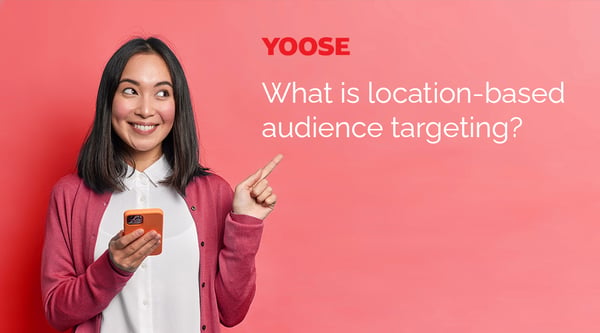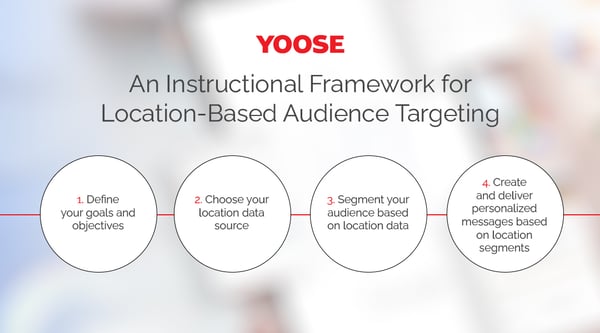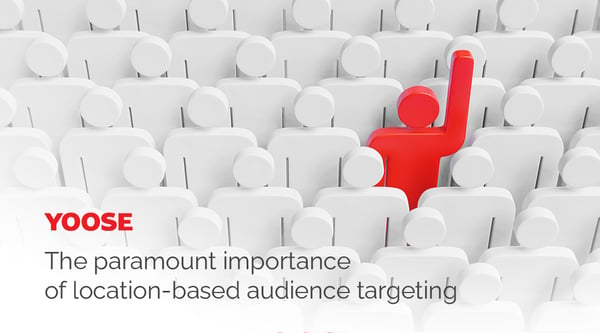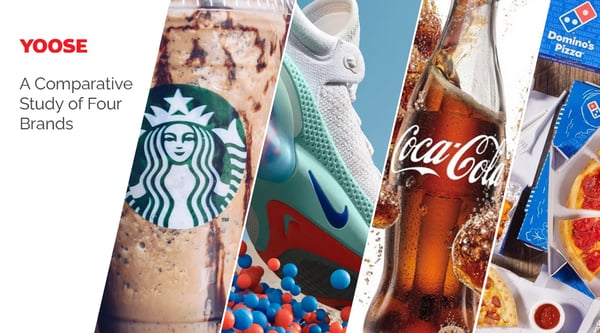A Comprehensive View of Location-Based Audience Targeting
Location-based audience targeting (LBAT) is a marketing strategy that leverages the geographic location of potential customers to deliver relevant and personalized messages. LBAT enables marketers to segment and target audiences based on various criteria, such as proximity, behavior, demographics, and preferences. This blog post aims to provide an overview of LBAT, its mechanisms, and its advantages for businesses. Additionally, it offers some guidelines and suggestions for effective implementation of LBAT.
What is location-based audience targeting?
Location-based audience targeting is a marketing strategy that uses the geographic location of potential customers to deliver personalized and relevant ads or messages.

For example, a restaurant chain might use location-based audience targeting to send coupons or discounts to people who are near one of their outlets, or a travel agency might use it to promote local attractions or events to tourists who are visiting a certain city.
An instructional framework for Location-Based Audience Targeting
1. Define your goals and objectives
Before you start targeting audiences based on their location, you need to have a clear idea of what you want to achieve. Is the goal to attract more customers to the store? Do you want to increase brand awareness in a specific area? Is it to advertise a special deal or a new product?
Having a clear goal and objective will help you measure the effectiveness of your campaign and optimize it accordingly.
2. Choose location data source
There are different ways to collect location data from your audience, such as GPS, Wi-Fi, Bluetooth, IP address, or geofencing. Each method has its own advantages and disadvantages in terms of accuracy, cost, and scalability. You need to choose the one that best suits your needs and budget. For example:
- GPS is the most accurate but also the most expensive and battery-draining method.
- Wi-Fi is cheaper and more reliable but requires users to connect to a network.
- Bluetooth is low-cost and low-energy but has a limited range. IP address is easy to obtain but can be inaccurate or spoofed.
- Geofencing is a technique that creates a virtual boundary around a physical location and triggers an action when a user enters or exits it. It is useful for sending timely and relevant notifications to users near your store or location of interest.

Once you have collected location data from the audiences, you can use it to segment them into different groups based on various criteria. For example, you might segment your audience based on their distance from your store, such as nearby, within walking distance, or within driving distance. The location context of your audience such as weather, time of day, traffic, or events, can also be used to segment them. Location history, such as frequent visitors, occasional visitors, or new visitors, are also useful.
4. Create and deliver personalized messages based on location segments
After you have segmented your audience based on their location data, you should create and deliver personalized messages that match their needs and preferences. For example, you can send a coupon or a discount code to users who are nearby your store or who have visited it before. Users who are within a walkable or drivable distance from the store or event can receive a reminder or an invitation. Users who are in a specific location context, such as weather, time of day, traffic, or events, can receive relevant content or an offer.
The paramount importance of location-based audience targeting
Location-based audience targeting can enable businesses to attain various advantages, such as:
- Increasing relevance and engagement: By delivering personalized and timely content that matches the context and interests of the audience, businesses can capture their attention and increase their likelihood of taking action.
- Improving customer loyalty and retention: By providing value-added services and offers that enhance the customer experience, businesses can build trust and loyalty with their audience and encourage repeat purchases.
- Driving footfalls: By sending timely and relevant messages or offers to users who are in the vicinity of your store, businesses can encourage them to visit your physical location and make a purchase.
- Reducing costs and waste: By targeting only the most relevant and qualified audience, businesses can optimize their marketing budget and avoid spending on ineffective or irrelevant campaigns.
- Enhancing customer experience: By providing useful and valuable information or content to customers based on their location context, such as weather, traffic, or events, businesses can improve their experience and engagement with the brand.

The process of footfall attribution involves several key steps. Firstly, a tracking pixel is fired when an ad is served, and the advertising ID is matched to a Customer Data Platform (CDP). Then, during and after the campaign, selected locations are monitored for store visits. The ID is automatically detected when the device owner enters a store, and the footfall is tracked. Finally, real-time offline attribution reports and footfall data streams are made available to provide detailed insights into the marketing campaign's success.
Overall, footfall attribution is an effective tool for businesses to determine the impact of their digital marketing campaigns on physical store visits. By implementing this technique, businesses can better understand their customers' behavior and tailor their marketing efforts accordingly.
An Examination of the Challenges and Solutions
Location-based audience targeting entails several difficulties for both marketers and consumers. Let’s examine some of these difficulties and propose possible solutions.
- Privacy and consent: One of the main challenges of location-based audience targeting is respecting the privacy and consent of users. Users may not want to share their location data with advertisers or may not be aware of how their data is used. Advertisers need to comply with the relevant laws and regulations regarding data protection and privacy, such as the General Data Protection Regulation (GDPR) in the European Union. They also need to provide clear and transparent information about their data collection and use practices, and obtain users' consent before accessing their location data. Users should also have the option to opt out of location-based advertising or adjust their privacy settings on their devices.
- Accuracy and quality: Another challenge of location-based audience targeting is ensuring the accuracy and quality of the location data. Location data can be obtained from various sources, such as GPS, Wi-Fi, Bluetooth, or cell towers. However, each source has its own limitations and errors, such as signal interference, low battery, or poor coverage. Advertisers need to verify the accuracy and quality of the location data they use, and avoid relying on a single source. They also need to consider the context and behavior of users, such as whether they are indoors or outdoors, stationary or moving, or visiting a place for work or leisure.
- Relevance and value: A third challenge of location-based audience targeting is delivering relevant and valuable ads to users. Users may not be interested in or responsive to ads that are based solely on their location, especially if they are intrusive or annoying. Advertisers need to understand the needs and preferences of users, and tailor their ads accordingly. They also need to provide value and incentives for users to engage with their ads, such as discounts, coupons, or rewards. Additionally, advertisers need to measure the effectiveness and impact of their location-based ads, and optimize their campaigns accordingly.
Optimal Methods for Implementing Location-Based Audience Targeting
To maximize the potential of location-based audience targeting, businesses need to take into account the following aspects:
- The accuracy and granularity of the location data. Marketers should use reliable sources of location data, such as GPS, Wi-Fi, or IP address, and choose the appropriate level of detail for their campaign goals. For example, if the goal is to drive foot traffic to a nearby store, a zip code level targeting may not be enough, but a street level targeting may be too intrusive.
- The relevance and timeliness of the message. You should tailor their message to the specific location and context of their audience, and deliver it at the right time. For example, if the goal is to promote a lunch deal at a restaurant, the message should be sent around noon when the audience is likely to be hungry and looking for options.
- The value proposition and call to action. Marketers should clearly communicate the benefits and incentives of their offer, and provide a clear and easy way for the audience to act on it. For example, if the goal is to increase app downloads, the message should highlight the features and advantages of the app, and include a link or a QR code to download it.
- The measurement and optimization of the results. You should track and analyze the performance of their location-based audience targeting campaigns, using metrics such as impressions, clicks, conversions, retention, and ROI. You should also test different variations of their message, offer, and targeting criteria, and optimize them based on the results.
The Effectiveness of Location-Based Audience Targeting: A Comparative Study of Four Brands

Starbucks
Challenge: Starbucks wanted to increase foot traffic and sales at its stores during the holiday season, especially among loyal customers who had the Starbucks app installed on their phones.
Solution: Starbucks used geofencing to create a virtual perimeter around its stores and send push notifications to app users who entered the area. The notifications offered them a limited-time deal on holiday drinks, such as peppermint mocha or gingerbread latte, and encouraged them to visit the nearest store.
Result: Starbucks reported a 100% increase in store visits and a 50% increase in sales from app users who received the geofenced notifications, compared to those who did not.
Nike
Challenge: Nike wanted to promote its new running shoes and encourage more people to join its running community.
Solution: Nike used location-based audience targeting to create a virtual race that challenged its consumers to run a certain distance within a given time frame. The consumers could track their progress and compare their results with other runners on a leaderboard. The consumers who completed the race received a discount code for the new running shoes and an invitation to join the Nike Run Club.
Result: Nike attracted over 500,000 runners to join its virtual race and increased its sales of the new running shoes by 18%. It also increased its membership of the Nike Run Club by 25%.
Coca-Cola
Challenge: Coca-Cola wanted to increase its market share and brand loyalty among young consumers.
Solution: Coca-Cola used location-based audience targeting to create a gamified campaign that rewarded its consumers for visiting different locations and scanning QR codes on Coca-Cola products. The consumers could collect points and redeem them for prizes such as movie tickets, concert tickets, or branded merchandise.
Result: Coca-Cola engaged over 1 million consumers with its campaign and increased its market share by 4%. It also increased its brand loyalty by 12% among the participants.
Domino's
Challenge: Domino's wanted to steal market share from its competitors and increase its pizza sales among hungry consumers who were looking for a quick and convenient delivery option.
Solution: Domino's used geo-conquesting to target its competitors' customers who were within a certain radius of its stores. It used mobile location data to identify when these customers were near a pizza place other than Domino's and sent them enticing offers via SMS or email, such as free delivery or discounts on large orders.
Result: Domino's achieved a 10% increase in pizza orders and a 5% increase in customer loyalty from its geo-conquesting campaign, as well as a lower cost per acquisition than its traditional marketing channels.
Conclusion
Location-based audience targeting is a powerful marketing strategy that can help businesses reach potential customers based on their geographic location and context. It can increase relevance, engagement, loyalty, foot traffic, sales, and customer experience. However, it also poses some challenges, such as privacy, accuracy, and value. At YOOSE, , we know how to define goals, choose location data source, segment audience, create and deliver personalized messages, and measure and optimize results in order to implement location-based audience targeting effectively.
Find out how you can use it to grow your business with our expert consultation. Book a call with us today!



